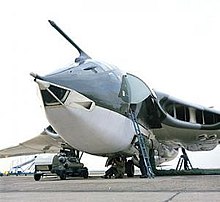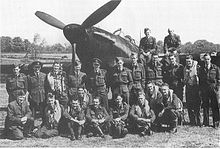RAF Wittering
Royal Air Force Wittering or more simply RAF Wittering (ICAO: EGXT) is a Royal Air Force station within the unitary authority area of Peterborough, Cambridgeshire and the unitary authority area of North Northamptonshire.
Although Stamford in Lincolnshire is the nearest town, the runways of RAF Wittering cross the boundary between Cambridgeshire and Northamptonshire.
From the flight's operational declaration in December 1916 until it deployed to France in November 1917, its BE2cs, RE7s, and FE2bs were involved in anti-Zeppelin patrols.
This conversion required another expansion with more land being purchased to the south and east of the station which closed the Stamford to Oundle road.
[14] Immediately after the war RAF Wittering, once again, transferred back to Fighter Command in 1946 providing a home to a variety of squadrons operating Spitfires, Mosquitos and Hornets.
[15] The current airfield was created by the merging of RAF Wittering and nearby Collyweston Relief Landing Ground, by the construction of a 1.7-mile runway between them in 1941.
A wide-span Gaydon hangar for the Canberra B2 bombers was constructed along with a new control tower, avionics building and nuclear storage and maintenance facilities.
[16] In its new guise as a bomber station, RAF Wittering initially operated Avro Lincolns from 1953 although these were replaced by English Electric Canberras later that year.
[15] The first British operational atomic bomb, the Blue Danube, was deployed to RAF Wittering in November 1953.
[15] The first V-bombers (the Vickers Valiant, the Handley Page Victor and the Avro Vulcan) were delivered in July 1955.
This was fitted into the existing Blue Danube casing, and four Valiant bombers flew out of Wittering to Christmas Island in the Pacific, one of them dropping the first device on 15 May 1957 on Operation Grapple.
[17] Until January 1969 two squadrons (100 and 139) of Victor B.2 bombers equipped with Blue Steel stand-off missiles were part of the QRA (Quick Reaction Alert) force of the RAF.
In times of higher tension, four bombers could be stationed beside the runway on the ORP (Operational Readiness Platform).
Since the incoming missile warning from the RAF Fylingdales BMEWS array was only four minutes before impact this ensured if the country came under attack, the bombers would be scrambled and able to retaliate.
[21] In 1982, six Harrier GR3 aircraft were taken down to the Falklands on SS Atlantic Conveyor,[22] and survived the Exocet attack, later to board HMS Hermes in May 1982.
On 27 May 1982, Sqn Ldr (later Gp Capt) Bob Iveson was hit by anti-aircraft fire from GADA 601's 35mm cannon, and he ejected seconds before his aircraft exploded in mid-air near Goose Green.
[34] Previously the home of No 1 Training Depot Station (at Stamford aerodrome) and No 5 Training Depot Station (at Easton on the Hill aerodrome) of the Royal Flying Corps during World War 1 and then the Royal Air Force's Central Flying School and No.







